There is probably no theme more banal than demography forecasts, but bear with me — after all, literally everything comes from population. Both consumption and production, commercial and governmental incomes and expenses, social opportunities and demands — all of it starts with people, serves people and ends with people. And so, the question “Okay, how much of us is and will be there exactly?”, no matter how many times asked, remains of utmost importance.
And Lithuania’s prospects in this regard look… actually hopeful and quite interesting.
And Lithuania’s prospects in this regard look… actually hopeful and quite interesting.
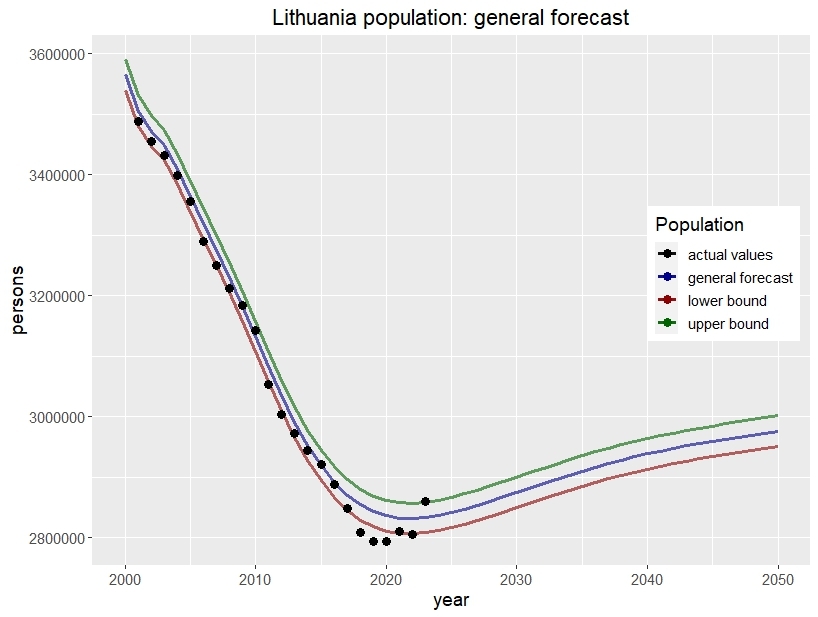
The trend was glaringly negative, it’s no secret — actually, it’s quite common knowledge, I believe — but it seems that the descent has stopped in recent years and is going to become its opposite in coming ones. The most important questions, of course, are how and why — to answer them, we need to talk about components of population change.
There are exactly four of them: live births, deaths, emigration and immigration. Quite obvious, really — there just are no other ways for people to come… and go.
So let’s take a look at these components in Lithuania’s case:
There are exactly four of them: live births, deaths, emigration and immigration. Quite obvious, really — there just are no other ways for people to come… and go.
So let’s take a look at these components in Lithuania’s case:
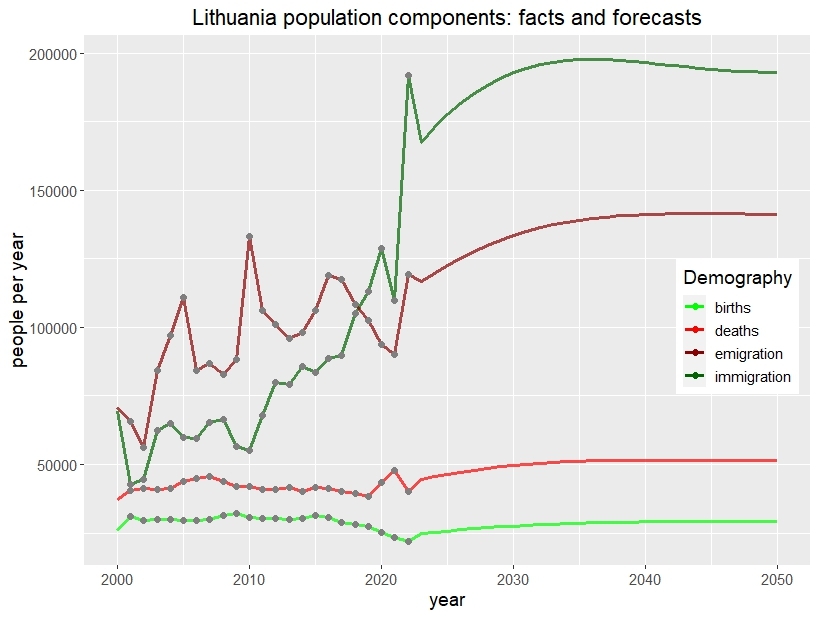
I would say this graph is actually quite self-explanatory… but we still will look into it in details.
***
Let’s combine births and deaths into natural population increase (or decrease) and immigration and emigration — respectively, into migratory one.
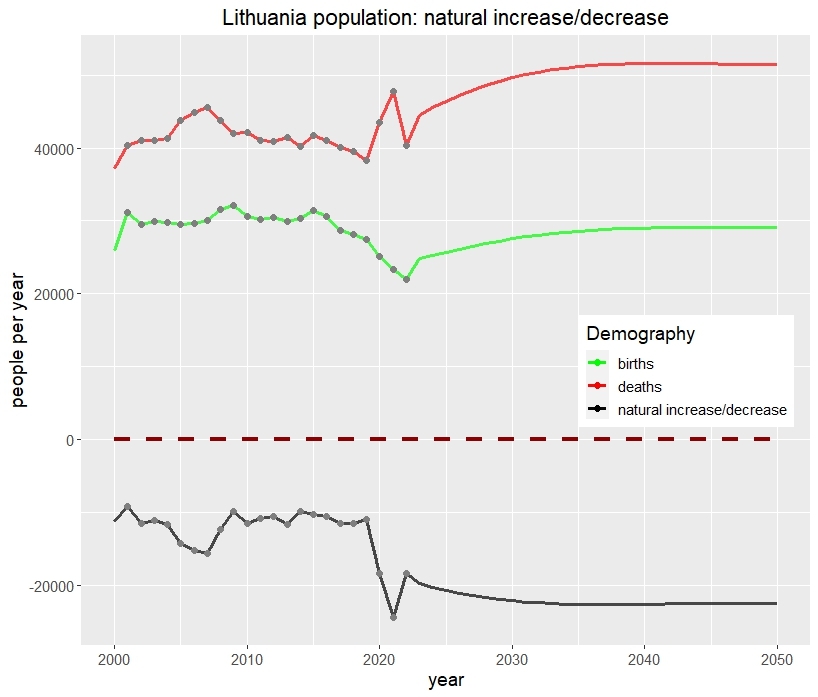
(Natural increase/decrease = births - deaths)
And here things… do not look so great. But at least for a while they were bad stably — but then COVID-19 have hit hard. And even if Lithuania recovers from it to the situation prior to pandemic, the grand total would still be noticeably less than zero. The trend of decreasing fertility has started long before, approximately at 2016, and it seems there are no premisses for increase high enough to mitigate deaths.
Bad news all around — let’s look at other part:
And here things… do not look so great. But at least for a while they were bad stably — but then COVID-19 have hit hard. And even if Lithuania recovers from it to the situation prior to pandemic, the grand total would still be noticeably less than zero. The trend of decreasing fertility has started long before, approximately at 2016, and it seems there are no premisses for increase high enough to mitigate deaths.
Bad news all around — let’s look at other part:
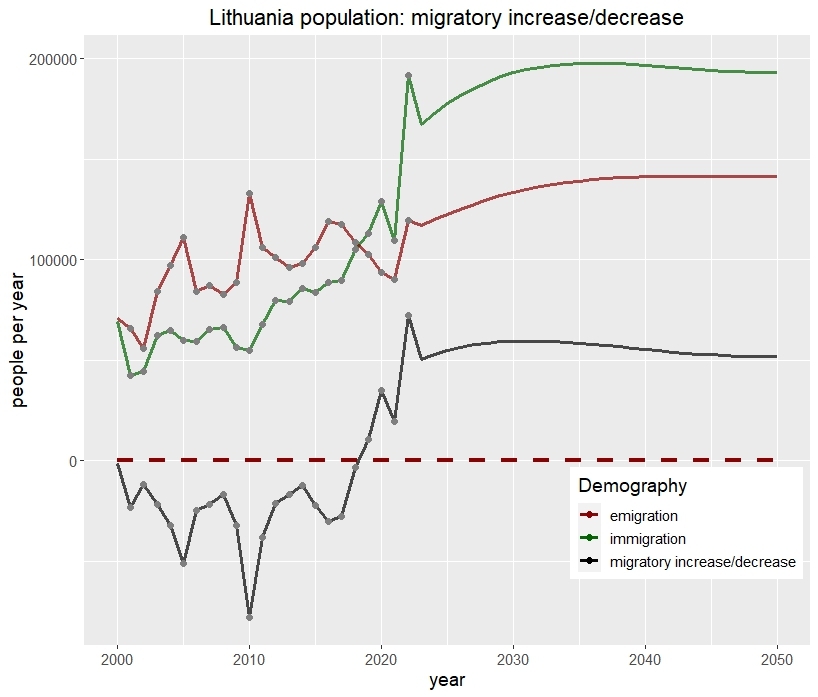
(Migratory increase/decrease = immigration - emigration)
And here we see entirely different situation: while the emigration may be defined as relatively stable (with a noticeable spike at 2010), the immigration in Lithuania has been rising since 2010. In 2013-2017 it stalled, but continued rising since 2018.
Dropped a bit in post-COVID year.
And jumped up in 2022. Most probably due to the Russo-Ukrainian War.
And while 2022 is an anomaly in its magnitude, the trend was there — migratory grand total became positive in 2019 and remained so since.
Quite interesting — let's sum it all up.
And here we see entirely different situation: while the emigration may be defined as relatively stable (with a noticeable spike at 2010), the immigration in Lithuania has been rising since 2010. In 2013-2017 it stalled, but continued rising since 2018.
Dropped a bit in post-COVID year.
And jumped up in 2022. Most probably due to the Russo-Ukrainian War.
And while 2022 is an anomaly in its magnitude, the trend was there — migratory grand total became positive in 2019 and remained so since.
Quite interesting — let's sum it all up.
***
Now we should be able to go back to the beginning and understand why we see what we see in terms of general forecast. We've examined natural increase/decrease of population (births minus deaths) and migratory one (immigration minus emigration) — let’s combine these two components:
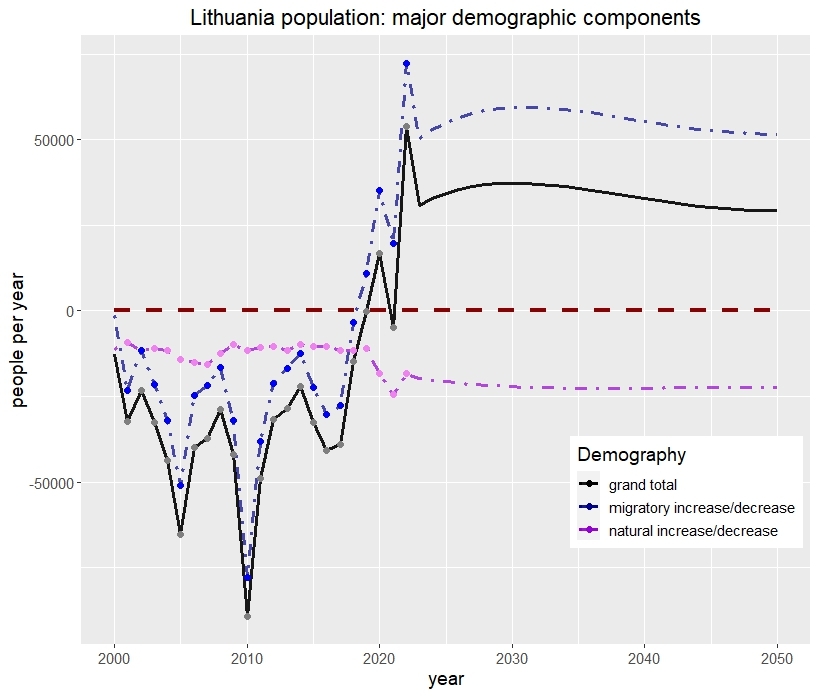
As we have already seen, the natural one is a decrease — the migratory one also was a decrease for years, but then the situation has changed. The grand total became positive, turned into increase, and that is why when we’re looking at general graph…

…we see a growing population.
The question is — how stable is the trend we’re now having and is it even actually accurate to call it a trend.
Deaths exceed births and this, it seems, is not going to change notably — the positive grand total is achieved through immigration. Which spiked up in unusual circumstances — meaning COVID-19 and Russo-Ukrainian war.
The numbers are what they are and why the forecasts, derived from them, look like they look is understandable. But here is the thing about crises: at first, they annihilate any predictions we make — and then create tendencies, for which longevity we can’t vouch.
Has the immigration in Lithuania been rising? Yes. Is it now high enough to compensate for natural decrease? Yes. Will it continue to be high enough?
Well, that remains to be seen.
Good news is — we, the Digital Twin company, have models which take into account interrelations between indicators, and so we can simulate and measure impacts of various events and decisions on fertility, mortality, immigration, emigration and whatever else is required.
Which is exactly what we’re going to do.
(Data source: Lithuania's official statistics data portal — https://osp.stat.gov.lt/)
The question is — how stable is the trend we’re now having and is it even actually accurate to call it a trend.
Deaths exceed births and this, it seems, is not going to change notably — the positive grand total is achieved through immigration. Which spiked up in unusual circumstances — meaning COVID-19 and Russo-Ukrainian war.
The numbers are what they are and why the forecasts, derived from them, look like they look is understandable. But here is the thing about crises: at first, they annihilate any predictions we make — and then create tendencies, for which longevity we can’t vouch.
Has the immigration in Lithuania been rising? Yes. Is it now high enough to compensate for natural decrease? Yes. Will it continue to be high enough?
Well, that remains to be seen.
Good news is — we, the Digital Twin company, have models which take into account interrelations between indicators, and so we can simulate and measure impacts of various events and decisions on fertility, mortality, immigration, emigration and whatever else is required.
Which is exactly what we’re going to do.
(Data source: Lithuania's official statistics data portal — https://osp.stat.gov.lt/)

